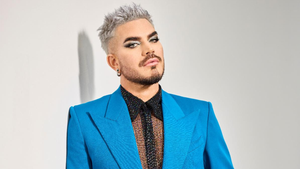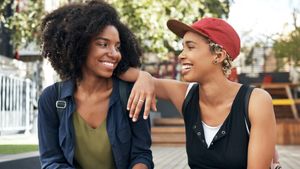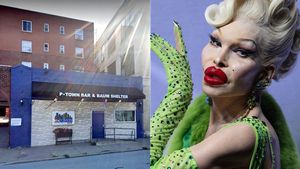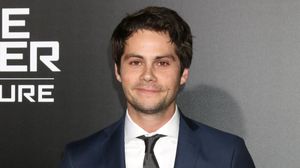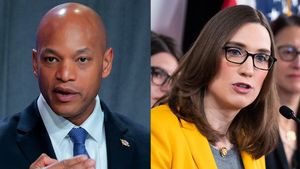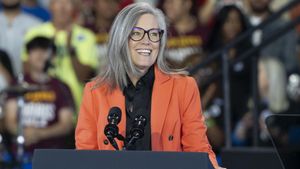Michael 'Chase' DiMartino is a new breed of Clark Kent. By day, the 26-year-old serves as a sign-language interpreter -- translating meetings for a deaf business woman in New York City. By night, the Bay Ridge, Brooklyn native is using his hands -- and his moves -- for another lofty purpose: To bring the likes of Britney Spears and Lady Gaga to the deaf and hearing-impaired communities through the art of sign language. After he posted interpretive videos of 'Womanizer,' Britney Spears herself had them posted to her website, bringing DiMartino's videos over the 700,000-viewer threshold. He's been asked to interpret Lady Gaga's upcoming sold-out show at Madison Square Garden (check out his sign-language video for 'Bad Romance' here). A singer-songwriter and performer in his own rite (he performed at Carnegie Hall at the age of 16), Chase is unveiling his own original material and, in doing so, hoping to bridge the hearing and deaf communities in a way that has never been done before.
Out: So break it down for me. What's your day job?
Michael 'Chase' DiMartino: I work as a sign language interpreter. I'm a personal interpreter for a deaf woman. My day consists of seven or eight meetings in which I interpret communications between the hearing people in the room -- ranging from lawyers to teachers -- and the deaf woman. Everything that's happening, I interpret.
How did you get into sign language in the first place?
I needed a language requirement ' and can't roll my r's in Spanish. It just didn't work. I used my hands a lot. And then after I took [the course] -- I remember it was like two or three weeks into it -- in college, I started to be really fascinated. It kind of hooked me. I felt like I was in the right place. And it snowballed from there. It took two years to learn the language and then two years to interpret it.
Describe the difference between learning and interpreting.
You learn the language as in the vocabulary. But when you're interpreting there are different modalities. You can sign word-for-word, which is called 'pigeon sign language' versus ASL [American Sign Language], which is strictly conceptualized. You can't just know vocabulary and be able to interpret. You can communicate, you can chat, but you can't necessarily interpret.
How do you make the bridge from a more formal sign-language interpreter and say, You know what, I really want to interpret music?
Prior to sign language -- I mean, I'm a New Yorker -- I'm an actor, singer. The whole extravaganza. I always felt the desire to perform. I've been in plays before. I've been reviewed by The New York Times. And when I learned sign language there was a class that was for music. They had a talent show and I said, I want to do something different, I want to do a rap song. And I did 'Gold Digger' from Kanye West on stage in front of a whole audience. And it felt like this is where I belong. And to see to the people there watching and loving it and knowing that it was something different that hasn't been done before, that was kind of the moment it happened.
Then what?
And then I decided -- let me see what people think on the Internet; I started getting views, and it started snowballing. And then I learned how to edit [video]. The next thing that happened was Britney Spears. I had done 'Womanizer' and her camp put it up on her website [see why by checking out Chase's video for that song herehere]. At that point I started thinking to myself -- it's really great doing other artists' songs'
But you want to share your own inspiration, too.
After 'Womanizer,' there was this shift in my mind, where I no longer wanted to do just that. I wanted to show people who I am, what my voice is, what my influence on music is. That's why I started to go into the studio and started to write songs with another artist, Adam Joseph. He did the instrumental and we wrote lyrics together.
So, as an artist, where are you right now?
It's been just a wonderful time. I have my videos, which are an extension of myself and now I feel like I have my music, which is an extension of myself and it really feels like a baby. I've always heard people say that but I never understood it until now. It feels like my baby. I put so much into this -- and it's my emotion. It's going onto a limb. It's taking a huge risk.
On the idea of risk, describe what it's like going into your day job and keeping that completely separate from your entertainment side.
It's actually really tough. Interpreting is my world. Sign language is my world. Music is my world.
But while it's your passion, it's something that you're hiding in a way, too. Especially from your coworkers, who you see every day. That can't be easy.
Interpreting is creative in and of itself. You have to learn how to take someone else's words, interpret them, and then put them out there in a manner that would be as understandable and as equivalent as the initial person wanted it to be. It has a degree of creativity, but you're bound. When you get be your own performer and your own artist you get to kind of realize the dream. There is this shift that happens. And to go into work and have to not tell my coworkers 'Hey, come to my show,' or, 'Hey, I'm recording this music.' It's hard. It's hard to go and sit in a cubicle in a quiet environment, when inside of me I'm ready to pop. It's not a desire, it's a necessity.
You're using one of the same skills, but they're very different jobs.
And they're two different hats. One is very professional and one is the [shirtless] guy with blood on his face in the video. So it's hugely different.
So tell me a little bit about your coworkers and what you think the reaction is going to be when they discover this other, shirtless, side of you?
My closest coworkers know. But the older ones'
And when you say 'older,' we're talking'
Sixty-five, 70 years old. I'm not sure what the reaction will be. I'm very playful at work so I don't think it'll be a shock to them. But I think that it will be, um, I definitely think if they come and see the show it will be something they've never seen before. And something they might not expect of me. You know, singing [my own song] called 'Hard Candy,' making these innuendos, thrusting. All that kind of stuff' things that come with performing. [Pauses] It might be better if they don't. [Laughs.]
But they're invited, of course'
They're invited. Absolutely.
Tell me about the show you've got coming up in New York [at the Laurie Beechman Theatre on Sunday, June 20.]
It's about 45 minutes. We pack in six songs, a dance break. I'll be doing a YouTube set, which is two or three videos, and I'll be showcasing four of my songs that will be coming out on the upcoming album. I have backup dancers, who are going to be showing you the full-on brunt of what dance is -- and they also learned sign language. They're coming forward and they're signing the chorus with me. We're all coming together.
What I find interesting is that music is, inherently, about sound. Well, there are two components -- lyrics and sound. But for a hearing person, music is about sound. People who are going to come to your shows will be both hearing and deaf and, in a way, they're essentially going to be experiencing the same thing -- but differently.
Here's the thing. When you learn to interpret, you're learning to relay a message equally. So the question that's posed to me is how can I deliver this message equally? How can I show you what music should look like? You might think at first that it's a little tricky. But we've been watching music since forever. We watch dance. That's music. And if you shut off the volume, you'll see [artists] moving to music. You'll see contemporary, you'll see the slow, a ballad, you'll see hip-hop -- it's much faster. If you can imagine each pop-and-lock having a different lyric attached to it. All of a sudden you're understanding a song by the rhythm. You can look at it and you know: that's music.
What's it like building the bridge between the hearing and the deaf communities?
It's almost like it's the epitome of what I'm trying to do. I'm trying to take dancers who are from a music world and show them what music could mean in the deaf world by teaching them sign. And, ultimately, I'm taking sign language and bringing it to the music world. So it really is a collision of two different worlds.
Two worlds that are similar in way, but haven't necessarily seen that connection?
Never before has this been done. So it's going to be interesting. If you've ever watched an interpreter, there's something very fluid about it, something very beautiful about it. And a lot of the hearing people who I come across and they ask me what I do, they say, 'Wow. I'm always drawn to watching an interpreter.' So you can easily see how it can be portrayed as poetry, as music.
And you're finishing up your debut album. It's slated for August, right?
Yeah, the album is coming out August 1. And that has taken about nine months to put together. Let me tell you something. That is nine months of every single week in the studio. That is nine months of a lot of, I mean there were days when I went home and I cried in the shower because I could not think of how to express something, of how to make it sound. It's a lot of juggle -- a lot of what do I want to hear, what do I want to portray. Down to the smallest breath at the beginning of a song.
What's the range of the album?
There's dance. There is a very '90s-influenced song called 'Nasty Habit.' It's very, very mid-'90s pop. 'Fall Down,' which is out right now [on iTunes], is a dancey track. 'Hard Candy' is a dancey track. That's out right now but I'm still doing some stuff with it. I've already added a lot that makes it much more dance-worthy. But I've left it there because it's a progress and I'm not afraid to show people a progression. They can see the flaws. That's part of it. I'm not an artist who thinks that you have to see me as a perfect person. I'm not an artist who's going to sing perfectly. I'm going to perform for you and hopefully you are entertained.
You're interpreting Lady Gaga's show at Madison Square Garden this fall. How did that come about?
There is an agency that works at Madison Square Garden. And they are in charge of getting interpreters for the events there. There just so happened to be a deaf person that wanted to go see Gaga. And they contacted me directly because they saw my [version of the] 'Bad Romance' video.
That's exciting, huh?
Can you imagine? I have this dream where Gaga's like, 'Where's that interpreter ' I know he's here. Come up here and do 'Bad Romance,' and I'm like, 'OK!' I would totally do that.
Ideally, where do you see yourself in a year?
The ideal is to be up there on the charts -- that is the ultimate goal. And to be the first pop star to bring in the deaf and hard of hearing [communities]. You know, I'm not imagining that I'm always going to be signing everything I'm doing. I'm imagining huge plasma TVs, with hands going, and I'm singing, but [sign] is there. And you've got half the stadium -- deaf and hearing people all together. Let's do it. I want to start a movement.
Clearly a lot of work has gone into getting to this point ' as you've been performing. Does it feel like you're starting to birth this baby now?
I'm eight months.
You're eight months pregnant?
Yeah [laughs]. I feel like it's flint right now. I'm trying to draw sparks. I'm trying to make people see the fire that's about to happen. And I just need a wind to catch it.
Chase makes his first full-length live performance at the Laurie Beechman Theatre in New York City on Sunday, June 20 (head here for tickets). This summer, he interprets for Lady Gaga at Madison Square Garden, Joan Rivers, and drag star Jackie Beat. He also heads to Europe to perform his original material abroad. Chase is putting the finishing touches on his debut album, Nasty Habit, which is expected out on iTunes on August 1. For more on Chase, including tickets to upcoming performances, visit his official website.
Send a letter to the editor about this article.




































